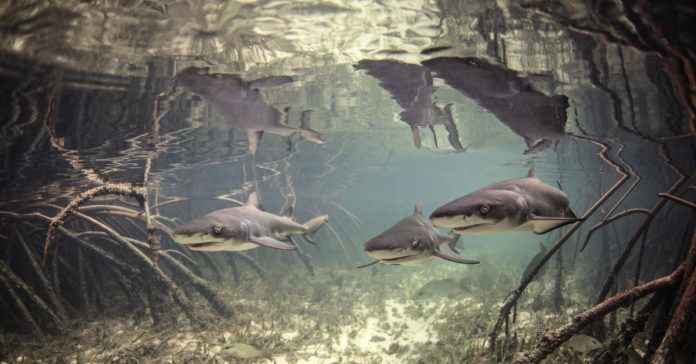Growing up as a shark can be tough. You not only have to worry about being eaten while still inside your mom’s womb, but when you finally pop out, there is no parental care! From the second you hit the water, you’re on your own… and usually pretty small! So, while Momma Shark might not take care of her babies (called ‘pups’) in a traditional sense than we are used to, she does try to give them their best fighting chance by giving birth in a nursery.
The lemon shark (Negaprion brevirostris) is one of many species in the Caribbean that use a nursery, … [+]
Getty
Many species of tropical sharks use semi-enclosed bodies of shallow water such as bays and estuaries as a nursery. Mangrove environments and seagrass meadows are the preferred habitat for some while other coastal sharks are adapted to use open systems such as bays, river deltas, shallow beaches, and other coastal fringe habitats.
Knowledge about the characteristics of shark nursery areas is mostly based on coastal species due to it being easier to observe them than their pelagic counterparts (and some pelagic sharks don’t even use nurseries). In warm temperate to tropical regions, the nurseries are often highly productive, semi-enclosed habitats, typically surrounded by mangroves, sandbars, or reefs – structures that make it tough for larger sharks to infiltrate and prey upon the growing pups. The time young sharks spend in nurseries depends on both biotic and abiotic factors that aren’t fully understood.
The lemon shark (Negaprion brevirostris) is one of many species in the Caribbean that use a nursery, and much of what is known about their reproduction and nursery areas is from long-term studies in the Bahamas over several decades. They were first described by Cuban ichthyologist Felipe Poey more than 150 years ago as a species found in Cuban waters but are have a larger tropical distribution in the Atlantic Ocean, Caribbean, and Eastern Pacific. They prefer warm, shallow waters with sandy bottoms and are known to use coastal habitats (e.g. mangroves) to give birth and provide food and protection from predators for the young.

To learn more about the sharks calling this area home, the team had to do more than just casually … [+]
getty
But the Bahamas may not be the only lemon shark hotspot in the Caribbean Sea. On the southwestern coast of Cuba is La Salina Wildlife Refuge, overseen by the Empresa para la Conservación de la Ciénaga de Zapata (Zapata Swamp Conservation Enterprise). Here, a field station stands that monitors the local wildlife… including small lemon sharks. Based on these casual observations, a team led by scientist Alexei Ruiz-Abierno of the Centro de Investigaciones Marinas (Universidad de La Habana) conducted an exploratory survey to see how why how these sharks were using the protected habitat. “The study was responsive to research needs specified in the National Plan of Action (NPOA) for sharks in Cuba, with a goal of informing both fisheries management and conservation initiatives for sharks in Cuban waters,” stated the authors.
La Salina Wildlife Refuge is a semi-enclosed refuge, protected by thick mangrove roots to bar any big animals from coming inside. It is constantly nourished by the several openings it has into the Gulf of Cazones and the Caribbean Sea, an easy exit for the young sharks when they feel they have outgrown the area. Human activity in the area is practically nonexistent, with fishing inside the refuge is prohibited (except for the catch-and-release recreational fly fishing). To learn more about the sharks calling this area home, the team had to do more than just casually observe them… they had to capture them. Different hook-and-line methods were used, and the captured sharks were then measured, sexed, weighed, tagged, and released. The researchers were even able to identify how old the sharks were by whether or not they had an open umbilical scar (making them neonates) or were juveniles with closed umbilical scars.
Two species of sharks were caught, lemon sharks (101) and nurse sharks, Ginglymostoma cirratum (5). The five nurse sharks were found only in deeper waters, close to the openings that connect the La Salina system to the deeper water of the Gulf of Cazones. On the other hand, the lemon sharks were captured mostly in the shallow waters of the coastal lagoons and the margins of mangrove keys, showing no evident patterns of size or sex distribution. “We captured only one lemon shark longer than 3 feet (1 meter), in the southeast part of the area close to an opening to the Gulf,” the authors said. “The capture of this individual was consistent with local fishing guide information that bigger sharks are spotted in the deepest areas close to the entrances or channels on the southern border.”

The habitat for juvenile lemon sharks in La Salina is consistent with the conventional description … [+]
Getty
“Our study was based on an extremely small sample size, so more research is needed on juvenile lemon shark growth in La Salina,” the authors stressed about their findings. “The habitat for juvenile lemon sharks in La Salina is consistent with the conventional description of this species’ nursery areas, which include shallow and semi-enclosed marine/estuarine systems that have been extensively documented mainly in the Bahamas and areas of the Southwest Atlantic.”
Although Cuba does not have any specific marine protected areas (MPAs) designated for elasmobranchs, the Cuban NPOA-Sharks is in the process of recognizing and studying critical habitats for sharks in Cuban waters. “With strong enforcement of refuge regulations, difficult access (being surrounded by a swamp), and isolation from human population centers, the lemon sharks of La Salina represent early life stages that likely are unaltered by significant human impacts,” the authors said.
Credit: Source link































